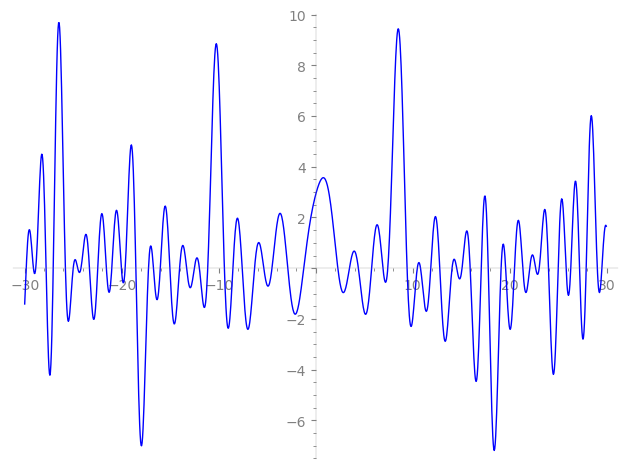| L(s) = 1 | + (1.97 + 0.339i)2-s − 1.73i·3-s + (3.76 + 1.33i)4-s − 7.77i·5-s + (0.588 − 3.41i)6-s + 3.49i·7-s + (6.97 + 3.92i)8-s − 2.99·9-s + (2.64 − 15.3i)10-s + (5.87 − 9.29i)11-s + (2.32 − 6.52i)12-s − 9.18·13-s + (−1.18 + 6.89i)14-s − 13.4·15-s + (12.4 + 10.0i)16-s − 9.57i·17-s + ⋯ |
| L(s) = 1 | + (0.985 + 0.169i)2-s − 0.577i·3-s + (0.942 + 0.334i)4-s − 1.55i·5-s + (0.0981 − 0.568i)6-s + 0.499i·7-s + (0.871 + 0.490i)8-s − 0.333·9-s + (0.264 − 1.53i)10-s + (0.534 − 0.845i)11-s + (0.193 − 0.543i)12-s − 0.706·13-s + (−0.0849 + 0.492i)14-s − 0.898·15-s + (0.775 + 0.631i)16-s − 0.563i·17-s + ⋯ |
\[\begin{aligned}\Lambda(s)=\mathstrut & 264 ^{s/2} \, \Gamma_{\C}(s) \, L(s)\cr =\mathstrut & (0.475 + 0.879i)\, \overline{\Lambda}(3-s) \end{aligned}\]
\[\begin{aligned}\Lambda(s)=\mathstrut & 264 ^{s/2} \, \Gamma_{\C}(s+1) \, L(s)\cr =\mathstrut & (0.475 + 0.879i)\, \overline{\Lambda}(1-s) \end{aligned}\]
Particular Values
| \(L(\frac{3}{2})\) |
\(\approx\) |
\(2.49748 - 1.48997i\) |
| \(L(\frac12)\) |
\(\approx\) |
\(2.49748 - 1.48997i\) |
| \(L(2)\) |
|
not available |
| \(L(1)\) |
|
not available |
\(L(s) = \displaystyle \prod_{p} F_p(p^{-s})^{-1} \)
| $p$ | $F_p(T)$ |
|---|
| bad | 2 | \( 1 + (-1.97 - 0.339i)T \) |
| 3 | \( 1 + 1.73iT \) |
| 11 | \( 1 + (-5.87 + 9.29i)T \) |
| good | 5 | \( 1 + 7.77iT - 25T^{2} \) |
| 7 | \( 1 - 3.49iT - 49T^{2} \) |
| 13 | \( 1 + 9.18T + 169T^{2} \) |
| 17 | \( 1 + 9.57iT - 289T^{2} \) |
| 19 | \( 1 - 2.05T + 361T^{2} \) |
| 23 | \( 1 - 17.6T + 529T^{2} \) |
| 29 | \( 1 - 12.3T + 841T^{2} \) |
| 31 | \( 1 + 19.2T + 961T^{2} \) |
| 37 | \( 1 - 44.5iT - 1.36e3T^{2} \) |
| 41 | \( 1 - 69.4iT - 1.68e3T^{2} \) |
| 43 | \( 1 - 85.3T + 1.84e3T^{2} \) |
| 47 | \( 1 + 48.4T + 2.20e3T^{2} \) |
| 53 | \( 1 - 40.3iT - 2.80e3T^{2} \) |
| 59 | \( 1 - 21.1iT - 3.48e3T^{2} \) |
| 61 | \( 1 + 93.1T + 3.72e3T^{2} \) |
| 67 | \( 1 + 101. iT - 4.48e3T^{2} \) |
| 71 | \( 1 - 0.423T + 5.04e3T^{2} \) |
| 73 | \( 1 - 56.5iT - 5.32e3T^{2} \) |
| 79 | \( 1 - 56.1iT - 6.24e3T^{2} \) |
| 83 | \( 1 + 86.5T + 6.88e3T^{2} \) |
| 89 | \( 1 - 83.2T + 7.92e3T^{2} \) |
| 97 | \( 1 + 64.2T + 9.40e3T^{2} \) |
| show more | |
| show less | |
\(L(s) = \displaystyle\prod_p \ \prod_{j=1}^{2} (1 - \alpha_{j,p}\, p^{-s})^{-1}\)
Imaginary part of the first few zeros on the critical line
−11.99166235385627614907305201532, −11.13344441864319292024795419843, −9.415350619167571163253427232015, −8.536564551897440100769677913420, −7.58124273801059629567881686867, −6.30795957022112286487768533059, −5.35215620729927918987798657038, −4.50941569524692748143303322485, −2.88097199399217429817137114446, −1.23341387099505965023676258141,
2.28018384380084992631145771927, 3.47582317204385155897595923855, 4.39684528782289359550115533689, 5.76126291158223068481880402111, 6.92921895837930562234974097258, 7.42635082604166782925066905654, 9.416232173226726777825625738591, 10.46867141225528095506140565312, 10.80368308403436367417396575326, 11.85624401226980223764652401116

